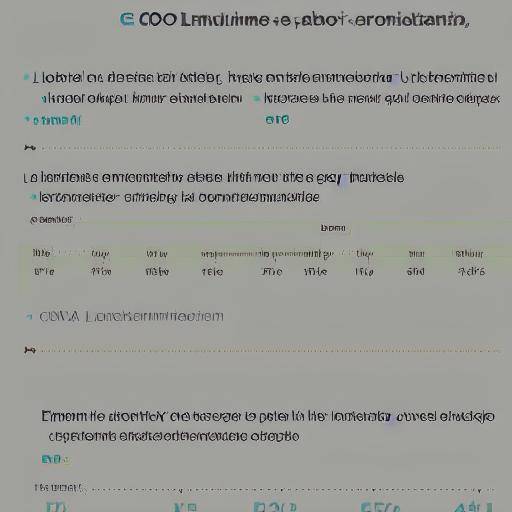
The working environment is a space in which we spend much of our time, and therefore it is crucial that we be able to set healthy limits to ensure our productivity and well-being. In this article, we will explore the importance of setting limits in the working environment, the challenges we face in doing so and how this impacts our productivity. In addition, we will provide practical advice and in-depth analysis to help you effectively manage your limits in the working environment.
Introduction
In the busy working environment today, it is common to find the difficulty of establishing clear limits between work and personal life. The technology keeps us constantly connected, blurring the lines between working time and personal time. This lack of limits can result in exhaustion, stress and a decrease in productivity. It is therefore essential to understand the importance of establishing healthy limits in the working environment and to learn effective strategies to achieve this.
History and Background
The concept of setting limits in the working environment has its roots in the human need to balance work and personal life. Throughout history, human beings have struggled to find a balance between their labor responsibilities and their well-being. From the first forms of labour organization to the modern era, limit management has been a constant concern.
Evolution in the Labour World
The advent of the industrial revolution marked a turning point in the way people perceived the work. With the standardization of working days and the emergence of factories, people had to clearly define their time of work and personal time. As technology has evolved, the ability to set limits has become even more challenging.
Significant Milestones and Developments
The emergence of labour laws and trade union movements has been fundamental in the struggle to establish fair limits in the working environment. The introduction of paid leave policies, regulations on the duration of the working day and the recognition of workers ' rights has contributed significantly to the management of labour limits.
Deep analysis
The proper management of limits in the working environment entails numerous benefits. People who can set healthy limits experience greater labor satisfaction, stress reduction and increased productivity. On the other hand, the inability to set limits can result in exhaustion, lack of motivation and decrease in labour performance.
Current Challenges and Trends
In the digital era, technology has played a dual role in managing limits in the working environment. While it has provided flexibility in terms of schedules and location, it has also generated a greater difficulty disconnecting from work. Telecommuting, in particular, has further blurred the boundaries between working life and staff, presenting unique challenges for border management.
Statistics and Prácticos Examples
According to a recent study, 70 per cent of workers report that the lack of limits between work and personal life affects their ability to concentrate. In addition, it has been observed that people who establish clear limits in the working environment experience lower levels of emotional exhaustion.
Dissimilar perspectives and opinions
Time management and well-being experts offer varied perspectives on how best to set limits on the working environment. Some advocate setting strict schedules, while others promote flexibility as a key to effective boundary management.
Full review
Effective management of limits in the working environment is crucial to promoting productivity and well-being. As we enter into the best practices and approaches for establishing healthy boundaries, it is essential to consider the different methods and approaches that can be applied in various working environments.
Strategies and Best Practices
There are multiple strategies to establish healthy limits in the working environment, from setting defined working hours to practicing self-care and digital disconnection. The implementation of active pauses, time for rest and physical separation between work and personal space are essential practices to foster healthy boundaries.
Different Methods and Approaches
The management of limits in the working environment varies according to the type of work, organizational culture and individual preferences. Some companies have implemented flexible teleworking policies, while others have set strict limits on working hours. The diversity of approaches emphasizes the importance of adapting boundary management strategies to individual needs and specific labour contexts.
Comparative analysis
The relationship between the working environment, healthy boundaries and productivity is intrinsic and complex. It is crucial to understand how these three elements interact and influence each other.
Synergies and Relations
Healthy limits in the working environment are directly correlated with workers' productivity. By establishing clear limits, employees can more effectively manage their workload, reduce exhaustion and maintain a high level of performance. Productivity, in turn, can be positively affected by the ability of employees to disconnect from work and spend time on Resources Recovery activities.
Examples and Scenarios
In a study conducted in a technology company, it was observed that the implementation of digital disconnection policies during free time resulted in a 15% increase in productivity and a 20% decrease in labour stress. This relationship between boundary management and productivity highlights the importance of establishing policies that promote healthy limits in the workplace.
Practical Tips and Accessible Tips
Here are practical tips for setting healthy boundaries in the working environment, as well as strategies to maintain and maximize productivity by doing so:
- Establish clear working hours and effectively communicate your availability schedules.
- Practice digital disconnection at the end of the working day to ensure rest and recovery time.
- Implement active breaks and scheduled breaks to maintain a healthy balance between work and rest.
- It promotes an organizational culture that values the personal integrity and well-being of employees.
- Prioritize your tasks and set limits on the amount of work you take to avoid exhaustion.
Industry Perspectives and Expert Reviews
Industry perspectives and expert opinions offer valuable insights on managing limits in the working environment and their impact on productivity.
Future Implications and Understanding of Trends
Industry experts anticipate a growing focus on promoting healthy boundaries in the working environment, especially as organizations recognize the positive impact it has on employee productivity and overall well-being. The balance between work and personal life has become a critical point to attract and retain talent in the current labour market.
Interviews and Quotes
According to Dr. Juan Pérez, a well-being expert, "The ability to set healthy limits in the working environment is fundamental to the mental and emotional health of employees. Companies that prioritize limit management are better positioned to maximize productivity and retain motivated and committed employees."
Case studies and practical applications
Case studies provide concrete examples of how the management of limits in the working environment has directly impacted the productivity and well-being of employees in various organizations.
Results and Lessons Learned
In a case of study carried out in a consulting firm, the implementation of flexible schedules and the promotion of healthy limits resulted in an increase of 25% in job satisfaction and an improvement of 30% in employee retention. This example highlights the importance of adapting limit management policies to the specific needs of each organization and its employees.
Examples Varied and Different Contexts
Case studies cover a wide range of industries and labour roles, from technology companies to health care organizations. These examples illustrate how effective management of limits in the working environment can be adapted and applied in different contexts to promote well-being and productivity.
Future Trends and Predictions
As the job landscape evolves, it is crucial to anticipate trends and predictions related to border management in the working environment.
Emerging Approaches and Potential Challenges
Organizations are expected to adopt more flexible and comprehensive approaches to border management, recognizing the diversity of employee needs and preferences. However, the challenge lies in balancing labour demands with the promotion of healthy limits, especially in an increasingly globalized and digitally connected working environment.
Opportunities and Potential Innovations
Innovations in technology and trends towards greater awareness of labour well-being offer opportunities for the implementation of tools and policies that foster healthy limits in the working environment. Businesses are expected to invest in solutions that support digital disconnection, manage labour burdens and promote an organizational culture that values the balance between work and personal life.
Conclusions
The effective management of limits in the working environment is critical to promoting the productivity and well-being of employees. By setting healthy boundaries, workers can reduce stress, improve their focus and maintain a healthy balance between work and personal life. By understanding and implementing effective strategies for setting limits in the working environment, organizations can maximize employee performance and foster a positive and sustainable working environment.
Frequently asked questions
Why is it so important to establish healthy limits in the working environment?
Establishing healthy limits in the working environment is crucial to protecting the emotional, physical and psychological well-being of employees. It also contributes directly to greater productivity and job satisfaction.
How can I set effective limits if I work in a highly demanding environment?
In demanding working environments, it is crucial to clearly communicate your limits and prioritize self-care. Establish defined working hours, practice digital disconnection and seek support within the organization are effective strategies.
What role do companies play in promoting healthy boundaries?
Companies have the responsibility to create an organizational culture that values the balance between work and personal life. This can be achieved through policies that promote digital disconnection, flexible schedules and active employee support to set healthy limits.
How can I maintain productivity by setting limits in my working environment?
By establishing healthy boundaries, it is essential to prioritize tasks, delegate responsibilities when necessary and practice effective time management. Setting clear limits will foster a greater focus and efficiency in your work activities.
What is the direct impact of limit management on labour productivity?
Effective management of limits in the working environment has been directly correlated with increased productivity, as employees can maintain a higher level of energy, concentration and commitment to their work tasks. By avoiding exhaustion and stress related to a lack of limits, employees can maintain high performance over time.
How can I negotiate healthy limits with my employer?
It is important to address this conversation proactively and constructively. Identify the limits you need to set to ensure your well-being and productivity, and propose solutions that benefit both you and the organization.
Conclusion
In understanding the importance of establishing healthy limits in the working environment and implementing effective strategies for achieving it, employees and organizations can foster a positive, productive and sustainable working environment. The management of limits not only benefits the emotional and physical well-being of workers, but also contributes directly to greater productivity and job satisfaction. By prioritizing the promotion of healthy boundaries, organizations show their commitment to the integral well-being of their employees, which in turn results in a healthier and more successful working environment.






















































